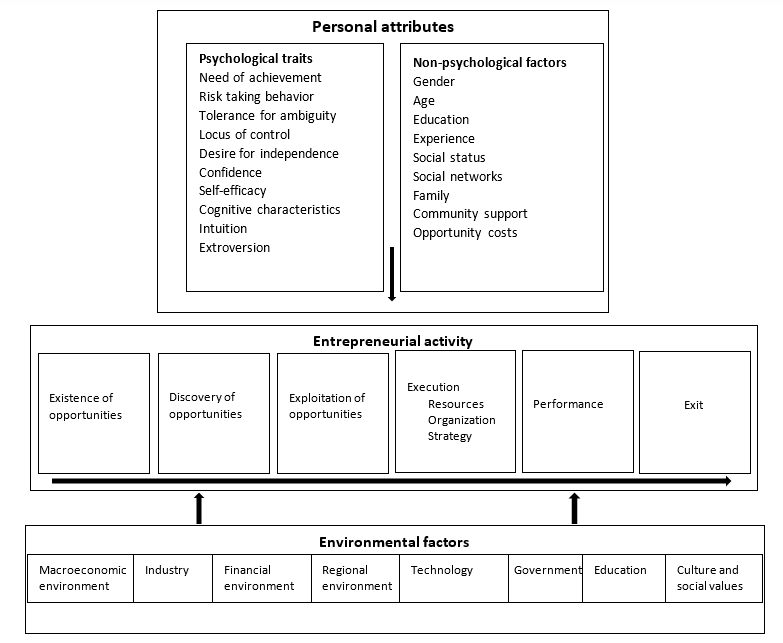
Entrepreneurship as a process
 ENTREPRENEURSHIP AS A PROCESS
ENTREPRENEURSHIP AS A PROCESS
Entrepreneurship as a process includes “all the functions, activities, and actions that are part of perceiving opportunities and creating organizations to pursue them” (Zacharakis, Bygrave , & Corbett, 2016, lk 46). Entrepreneurial process can be viewed as a nexus between individuals’ characteristics and environmental factors (Shane, 2003). The personal attributes and the economic, social, technological and institutional environment impact each step of the entrepreneurial process. Technological changes, social and demographic changes, changes in industry structures and regulatory environment create new opportunities for making profit from new products and services, new processing or organizing methods, new markets. However, the recognition of those opportunities is a subjective process (Shane & Venkataraman, 2000). Opportunity recognition refers to the cognitive process of detecting and connecting the information on the trends, changes in markets for the creation of new product and services (Ma, Huang, & Shenkar, 2011; Chang, & Chen, 2020). It depends on many factors such as individuals’ prior knowledge, information acquisition, luck, personal cognitive abilities to process information.
 Figure 1. Entrepreneurial process and personal and environmental factors affecting it. Source: adapted from Cuervo (2005, p. 299) and Shane (2003, p. 11- 12) with changes.
Figure 1. Entrepreneurial process and personal and environmental factors affecting it. Source: adapted from Cuervo (2005, p. 299) and Shane (2003, p. 11- 12) with changes.
Many researchers have approached entrepreneurial activity as a directional process. It starts with the appearance of opportunities, discovery of those by the entrepreneurs. Opportunities have to be evaluated before the decision to exploit them is made. The evaluation process includes determining the potential economic and financial rewards vs. costs, market size and industry dynamics, competition, risks, feasibility and desirability of the opportunity (Adel Rastkhiz, Mobini Dehkordi, Yadollahi Farsi, & Azar, 2019) and the fit with the personal skills and goals (Hisrich, Stanco, & Wisniewski , 2020).
After the decision to proceed with the idea is made, the exploitation activities include business planning, creation of organization, acquiring and recombing of physical, financial, knowledge, human resources, development of strategies and management practices. One of the most challenging aspects in the entrepreneurship process is acquiring the resources in a timely manner at the lowest possible cost and loss of control (Hisrich, Stanco, & Wisniewski , 2020). Resource are typically scare and entrepreneurs themselves possess a fraction of required resources. It is crucial that entrepreneurs evaluate which resources are more critical than others, what is the cost of acquiring them and which should be kept inhouse and which could be outsourced (Zacharakis, Bygrave , & Corbett, 2016). Entrepreneurial action is often characterized by bricolage that refers to utilization and recombination of existing resources in new manner for which they were not originally intended to be used (Hisrich, Peters, & Shepherd, 2017).
Entrepreneurial exit refers to the process by which the founders remove themselves from the enterprise they created (DeTienne, 2010). It can take place in the form of selling the enterprise and their equity to private equity firms, strategic buyers or in public offerings; transferring it to family members, employees or team member, or liquidating the enterprise because of a failure or voluntarily disbanding. The options available for exit tend to differ in the different phases of the life cycle (infancy, growth, maturity) (DeTienne, 2010), e.g. failure and disbanding more common in infancy phase, growing enterprises tend to be more attractive to buyers, transfers and selling of enterprises common in maturity phase.
Many researchers have emphasized that the entrepreneurship process is too heterogenous, complex and dynamic to be described as one directional linear process (Dimov, 2020). Instead it could be characterized as iterative process with feedback loops (Bhave, 1994; Pryor, Webb, Ireland, & Ketchen, 2016) that entrepreneurs utilize to decrease uncertainty and to adjust the activities.
-
What would be good empirical measures for entrepreneurial behavior?
-
What are the differences between entrepreneurship and intrapreneurship? What would be the negative and positive sides?
-
Business legislation is an important part of institutional environment affecting the entrepreneurship process. Since 2011, it has been possible to establish private limited companies in Estonia without the mandatory share capital of 2500 euros by deferring the payment. What have been the positive effects on this? What have been the negative effects of this?
-
Think of an entrepreneurial opportunity related to your field of study. What kind of specific resources would be critical for the successful exploitation of opportunity is this particular field?
-
Entrepreneurship is associated with specific personal characteristics. What do you think how permanent are those attributes or can those change over time?


